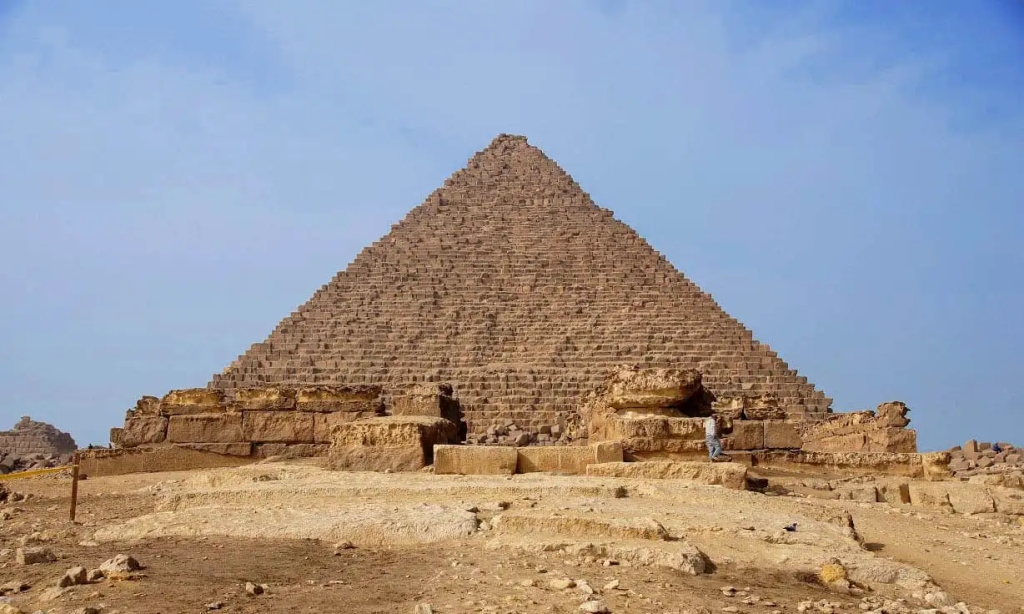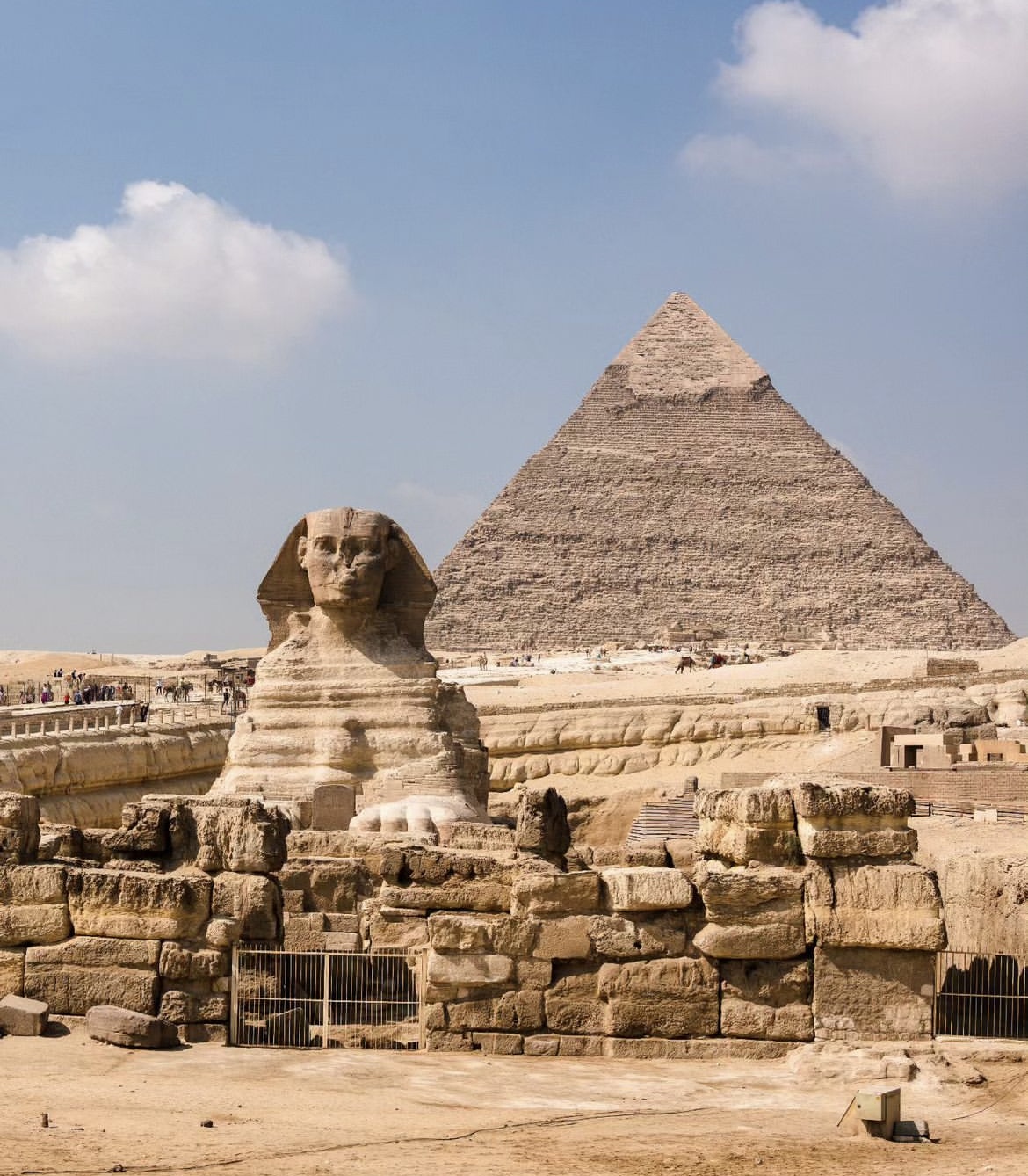
In the heart of the Giza Plateau, the Pyramid of Menkaure stands as a testament to the enduring legacy of ancient Egypt’s rulers and their pursuit of eternal life. Often overshadowed by its larger neighbors, the Pyramid of Menkaure, named after the Pharaoh Menkaure, holds its own unique significance in the pantheon of ancient wonders. This authoritative blog post will delve into the mysteries and cultural importance of the Pyramid of Menkaure, shedding light on its construction, purpose, and lasting impact.
1. A Testament to Elegance and Design
Constructed during the Fourth Dynasty of the Old Kingdom, around 2532-2503 BCE, the Pyramid of Menkaure exhibits a distinctive design characterized by a more modest scale compared to the neighboring pyramids. Despite its smaller size, the pyramid’s elegance and precision reflect the same architectural mastery that defined the era. It was built using Tura limestone and granite for its casing, which has partially eroded over time.
The pyramid’s original casing stones have been largely stripped away, revealing its inner core. Its precise construction techniques and the effort invested in its creation reflect the importance ancient Egyptians placed on ensuring a dignified resting place for their rulers.
2. Intriguing Funerary Complex and Statuary
The Pyramid of Menkaure’s complex includes the pyramid itself, a valley temple, a causeway, and a mortuary temple. The temples held immense spiritual significance, serving as the sites of rituals, ceremonies, and offerings dedicated to ensuring the pharaoh’s successful journey to the afterlife.
Within the pyramid complex, archaeologists have discovered intricately carved statues of Menkaure, providing insight into the ruler’s physical appearance and regal attire. These statues reveal the artistry and craftsmanship of the ancient Egyptians, as well as their belief in the importance of preserving the pharaoh’s image for eternity.
3. The Enigma of Purpose
While the primary purpose of the Pyramid of Menkaure was undoubtedly to serve as a tomb for the pharaoh, its smaller size and seemingly less ornate construction have led some to speculate about potential changes in the socio-political landscape during Menkaure’s reign. Questions arise about whether the reduced size was a result of practical considerations, available resources, or a shift in the pharaoh’s role in society.
Regardless of its size, the pyramid’s presence within the Giza Plateau underscores the continuity of ancient Egyptian funerary traditions and the pharaoh’s role as a divine intermediary.
4. Lessons from the Past
The Pyramid of Menkaure, though often overshadowed by the more prominent pyramids of Giza, offers valuable insights into the dynamics of ancient Egyptian society, their spiritual beliefs, and their unwavering reverence for their rulers. Its smaller scale does not diminish its significance but rather highlights the diversity of approaches taken by different pharaohs in their quest for immortality.
As we explore the Pyramid of Menkaure, we are reminded of the multifaceted nature of history and the layers of complexity that shaped the past. This monument serves as a reminder that even in the shadows of towering structures, there exist stories that enrich our understanding of the human journey through time.
Pyramid of Menkaure FAQs
1. What is the Pyramid of Menkaure? The Pyramid of Menkaure, also known as the Pyramid of Mycerinus, is the smallest of the three main pyramids at the Giza complex in Egypt. It was built for Pharaoh Menkaure, who ruled during the Fourth Dynasty of the Old Kingdom.
2. How does the Pyramid of Menkaure compare to the other pyramids at Giza? The Pyramid of Menkaure is the smallest of the three main pyramids at Giza. It stands at a height of around 65 meters (213 feet) and has a base measuring approximately 105 meters (344 feet) on each side.
3. What are the dimensions of the Pyramid of Menkaure? As mentioned earlier, the Pyramid of Menkaure has a height of around 65 meters (213 feet) and a base measuring approximately 105 meters (344 feet) on each side.
4. How was the Pyramid of Menkaure built? The construction of the Pyramid of Menkaure followed similar techniques to those used for the other pyramids at Giza. Limestone blocks were quarried and transported to the site, likely using ramps for elevation. It’s believed that the pyramid’s outer casing was made of finer quality limestone, but much of it has since eroded or been removed.
5. Does the Pyramid of Menkaure have any internal chambers? Yes, the Pyramid of Menkaure has a series of internal chambers, similar to the other pyramids at Giza. These chambers were designed for burial and ritualistic purposes. The pyramid has a vertical shaft leading to a subterranean chamber, as well as two more chambers above ground, one of which contains a granite sarcophagus.
6. What is the significance of the Pyramid of Menkaure? The Pyramid of Menkaure is significant as a testament to ancient Egyptian architectural and engineering achievements. It, along with the other pyramids at Giza, represents the grandeur and power of the pharaohs during the Old Kingdom.

